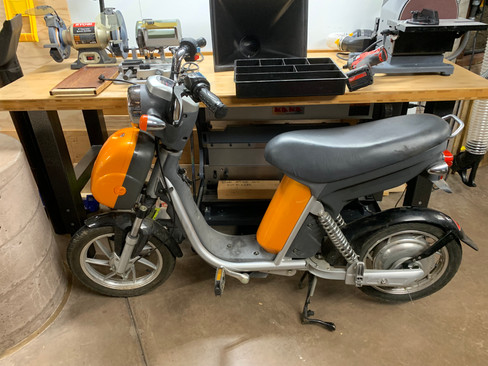Electric Moped
- Daniel Louie
- Oct 1, 2023
- 2 min read
Updated: Oct 22, 2024

When I began this project, I had already developed a fascination with e-bikes of all kinds. Specifically, I loved this slick looking, high-powered e-motorbike called the Onyx but it was too expensive and too dangerous, so I set out to make my own.
I spent months scouring the internet for a cheap starter bike that matched the look I was going for. I ended up buying an electric moped from an estate sale because the shape of the frame, dual suspension and rear hub motor fit my main criteria despite the bike itself being non-operational.
When I began taking it apart, I found a plethora of unlabeled wires and mysterious components. To make matters worse, no research yielded any helpful information or even identification about the model. For weeks, I painstakingly traced wires to their sources and learned how the moped worked from the inside out.
To get the bike to work, I first replaced the SLA batteries, the most likely problem, with new ones to no avail. Next, I replaced the motor controller with a super advanced Grin Technologies Phaserunner motor controller. This involved using a computer to optimize all sorts of settings on the motor controller to work with the unidentified original hub motor. This got the bike to work and it was able to hit speeds up to 36mph on flats. We bought a 52V Lithium-ion battery to compare with the 48V SLA and because switching to Li-ion would save nearly 30lbs.
Through this project, I learned about the importance of keeping track of components, changes, and testing. I logged every test ride on Strava to record every average mph, top speed, and range with every modification. After thorough testing, I decided on the Li-ion battery for its lighter weight, longer range and longer overall lifespan.
The next step was to modify the metal frame of the bike to add a tray for the new battery. For this, I learned how to do MIG (metal inert gas) welding which was a blast. Adding this skill to my belt opened a new world of possibilities for future projects that require the strength and durability of metal. In addition to the battery tray, I welded a custom front fork that helped the bike better resemble the look I was going for.
Next, I began working on the aesthetics of the moped. This included adding a traditional motorcycle headlight and seat. I bought a real motorcycle gas tank and cut out the shell to cover the battery but ended up not liking the look of it. I went through multiple designs and mock-ups for the frame design but eventually settled on black polycarbonate panels with a small compartment resembling a gas tank.
I am currently working on installing the panels and tank and will update this project page when I have completed the finishing touches!























Comments